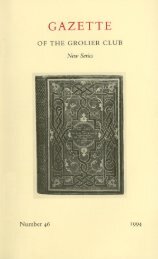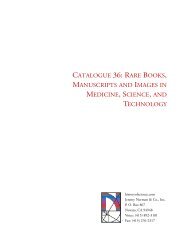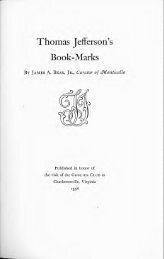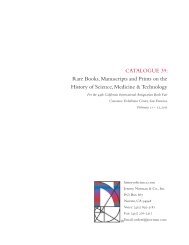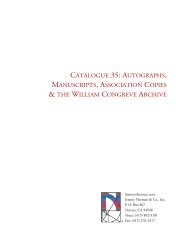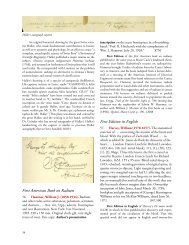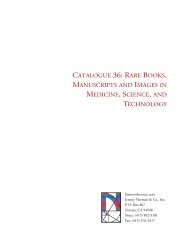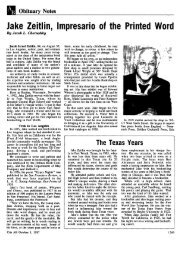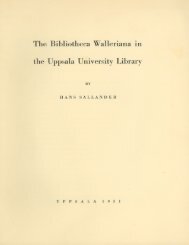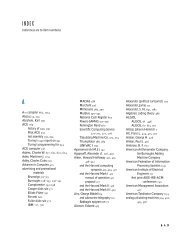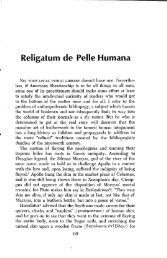Catalogue 38, Part 3 - Jeremy Norman's HistoryofScience.com
Catalogue 38, Part 3 - Jeremy Norman's HistoryofScience.com
Catalogue 38, Part 3 - Jeremy Norman's HistoryofScience.com
Create successful ePaper yourself
Turn your PDF publications into a flip-book with our unique Google optimized e-Paper software.
et; instead of hands, each clock had a rotating disk<br />
with a notch cut into it so that only one letter on the<br />
clock face was visible at a time (Standage 1998, 19).<br />
Ronalds placed one clock at each end of eight miles of<br />
insulated wire that he had laid down in his garden, and<br />
used electrical impulses to transmit signals between<br />
them. He wrote to Lord Melville of the British Admiralty<br />
offering to demonstrate his telegraph, but was<br />
rejected: John Barrow, secretary to the admiralty, wrote<br />
back to Ronalds saying that “telegraphs of any kind are<br />
now [after the conclusion of the Napoleonic wars]<br />
totally unnecessary, and that no other than the one<br />
now in use [a semaphore telegraph] will be adopted”<br />
(quoted in DNB). Ronalds did not pursue his telegraphy<br />
venture any further, but left a record of it in his<br />
Descriptions of an Electric Telegraph and of Some<br />
Other Electrical Apparatus (1823; reprinted in 1871 at<br />
the suggestion of Latimer Clark). It was left to Charles<br />
Wheatstone and William Fothergill Cooke, both of<br />
whom knew of Ronalds’s experiments, to develop the<br />
first telegraph adopted for public use in Britain in<br />
1845.<br />
In 1871, in response to a petition submitted the previous<br />
year to Prime Minister William Gladstone, Ronalds<br />
received a knighthood for his contribution to<br />
telegraphy. His letter to Clark expresses his gratitude<br />
for this honor and for Clark’s part in it:<br />
Your kind congratulations are peculiarly<br />
esteemed; for I have every reason to believe that<br />
your expressions of approbation &c. of my humble<br />
labours in Electro-Telegraphy have been influential<br />
in Her Majesty’s gracious act in my behalf.<br />
I believe it is almost needless to tell you that the<br />
honour conferred is much less valued by me than<br />
the testimony it helps to afford to the validity of<br />
my early labours in the matter. . . . “<br />
Origins of Cyberspace 187. 40745<br />
“Resurrection Men”<br />
93. Royal College of Surgeons. Anatomy.<br />
Copy of a letter from the Council of the Royal<br />
College of Surgeons in London, to Viscount Melbourne;<br />
dated 10 December 1831. Folio. 3pp.<br />
[London:] House of Commons, 17 December<br />
1831. 333 x 208 mm. Disbound, gutter margin a<br />
little frayed. Light toning but very good. $950<br />
First Edition. On December 5, 1831, the notorious<br />
London “resurrection men” John Bishop and<br />
Thomas Williams were executed for the murder of an<br />
itinerant fourteen-year-old (known only as the “Italian<br />
Boy”), whose corpse they had then attempted to sell to<br />
the anatomical demonstrator at King’s College. Five<br />
days later, the Council of the Royal College of Surgeons—whose<br />
members included such luminaries as<br />
Astley Cooper, William Lawrence, Benjamin Collins<br />
Brodie, Charles Bell and Benjamin Travers—sent the<br />
present letter to Viscount Melbourne, the British<br />
Home Secretary, urging reform of the antiquated British<br />
laws governing procurement and possession of<br />
cadavers for dissection in medical schools. The work is<br />
82



